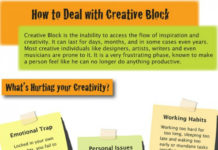
I have spoken with so many individuals over the years claiming to lack a creative bone. Others recognize they have the desire to be creative but do not exercise any form of strategies to stimulate their creative process. I personally believe that every individual has the ability to be creative. It is dependent upon finding the right accelerant or strategy that helps to gear your creative thinking forward.
5 Steps to Jump Starting Your Creativity
These five simple steps will help to get your creative thinking started.
1. Gather Raw Materials
Gather together any raw materials you want to experiment with and start learning their texture and pliability. Your initial curiosity will start to spur on inspiration as you start to manipulate your materials. Research and browse different information regarding the specific information you are after. Reading and interest is all it takes to spur on the initial motivation to get yourself started.
As Leo Burnett says, “Curiosity about life in all its aspects, I think, is still the secret of great creative people.”
2. Digest the Information
Once you gather your materials and information start to bring everything together and see what you do and don’t like as you manipulate. This is a perfect concept and as Steve Jobs admitted himself, “creativity is just connecting things.”
3. Do Not Over Think
You can tend to overwhelm yourself when you over think a project. Do not worry about getting that picture perfect result as a book may show, but rather focus on the process and what you personally prefer. Let your thoughts wander and do what it is that stimulates your own imagination.
Ray Bradbury once shared this creative quote, “Don’t think. Thinking is the enemy of creativity.”
4. Wait for the Ah-Ha Moment
A great idea can come at any time. Always travel with a notepad so you can document your grand idea when it hits. These Ah-Ha moments can strike at anytime. Keeping a record of these ideas will allow yourself to continue to feed the creative process while giving you a starting point to link together proceeding ideas and concepts for your final project.
As shared by Friedrich Nietzsche, “All truly great thought are conceived while walking.”
5. Bring Your Idea to Life
Now that you have those ideas flowing, you can work on bring them to life. Keep your creativity strong by sharing your ideas with others and gain feedback. If some of your ideas fail or do not work out as expected, be optimistic and try a new process to make it work. As Edward de Bono says, “It is better to have enough ideas for some of them to be wrong, than to be always right by having no ideas at all.”
Thinking Techniques and Strategies
Oblique Strategies to Relax the Mind
Developed by Brian Eno & Peter Schmidt, oblique strategies involve the phrases on cards that help to encourage lateral thinking. An example of these are:
• Go outside and shut the door.
• Change ambiguities to specifics.
• Cut a vital connection.
Lotus Blossom Technique
This technique was developed by Yasuo Matsumura and operates similar to a mind map. Beginning at a central idea, it expands outwards where solutions are provided in an iterative manner. Once the central idea space is filled, all other quadrants must be full before considering this process as completed.
The Six Thinking Hats
It is believed by Edward de Bono that an individual wears different metaphorical hats based on the type of thinking they are using. These are broken down to the follow.
• White Hat – Looks at the information and data.
• Red Hat – Covers your feelings, emotions, and intuition.
• Black Hat – Using judgment and caution.
• Yellow Hat – Find reasons why something will work.
• Green Hat – Look for alternatives, proposals, provocations, and changes.
• Blue Hat – The hat of control that looks at the thinking surrounding the subject, not the subject itself.
Are there any of these that you can identify with yourself using at times?
Mass Brainstorming
Write down a bulk of your ideas to release the sheer mass of ideas you have. This will prevent you from criticizing your own thoughts before they have become evolved.
Reverse Brainstorm
Start off with identifying the causes of the problem and then work towards a solution.
Limit Yourself
Working within limited constraints can help to stimulate more creativity and action.
Creativity is something that you can start right now. Try and keep trying, as innovation requires hard work. As Willy Wonka once said, “Invention, my dear friends, is 93% perspiration, 6% electricity, 4% evaporation, and 2% butterscotch ripple. Albert Einstein himself once agreed that, “We cannot solve our problems with the same thinking we used when we created them.”
BONUS: 10 Creative Thinking Tips
Follow these additional creative thinking tips to help improve your creative process and abilities.
1. Ask yourself questions any every. An inquiring mind is a creative one and helps to increase awareness.
2. Keep informed in your related industry and field so you are not applying yesterday’s thinking to a problem of today.
3. Engage in activities that will help you relax and be active such as exercising.
4. Have courage and self confidence to block any possible thinking barriers.
5. Continue to learn about yourself and increase your self-knowledge.
6. Learn about things outside of your comfort zone and specialty.
7. Avoid rigid patterns and overcome biases.
8. Be open and receptive to new ideas and others.
9. Be alert in your observations of similarities, differences, and distinguishing features.
10. Adopt a risk taking attitude and keep your sense of humor.





